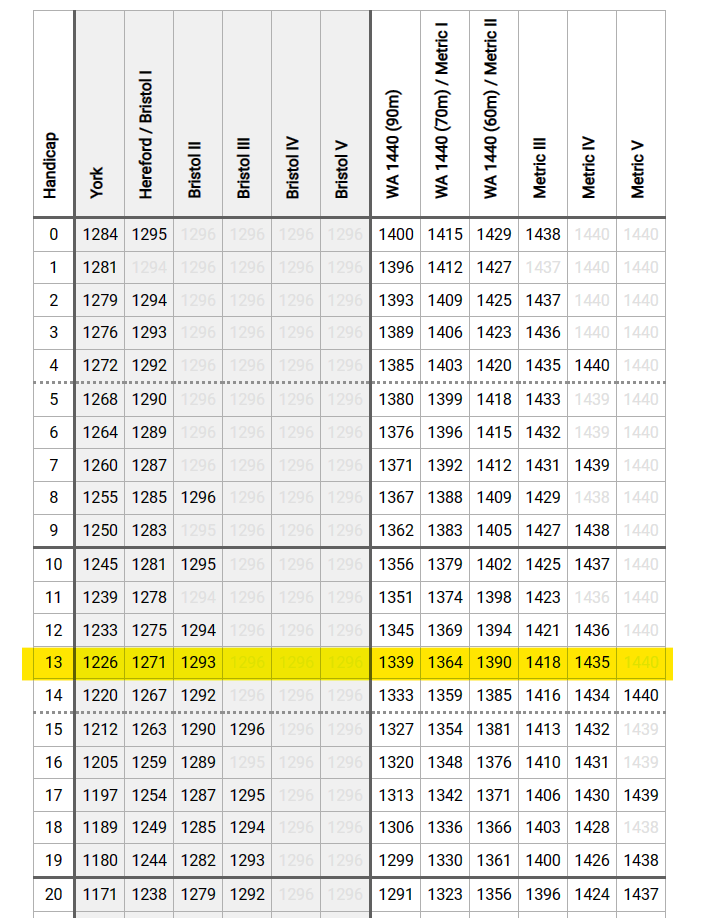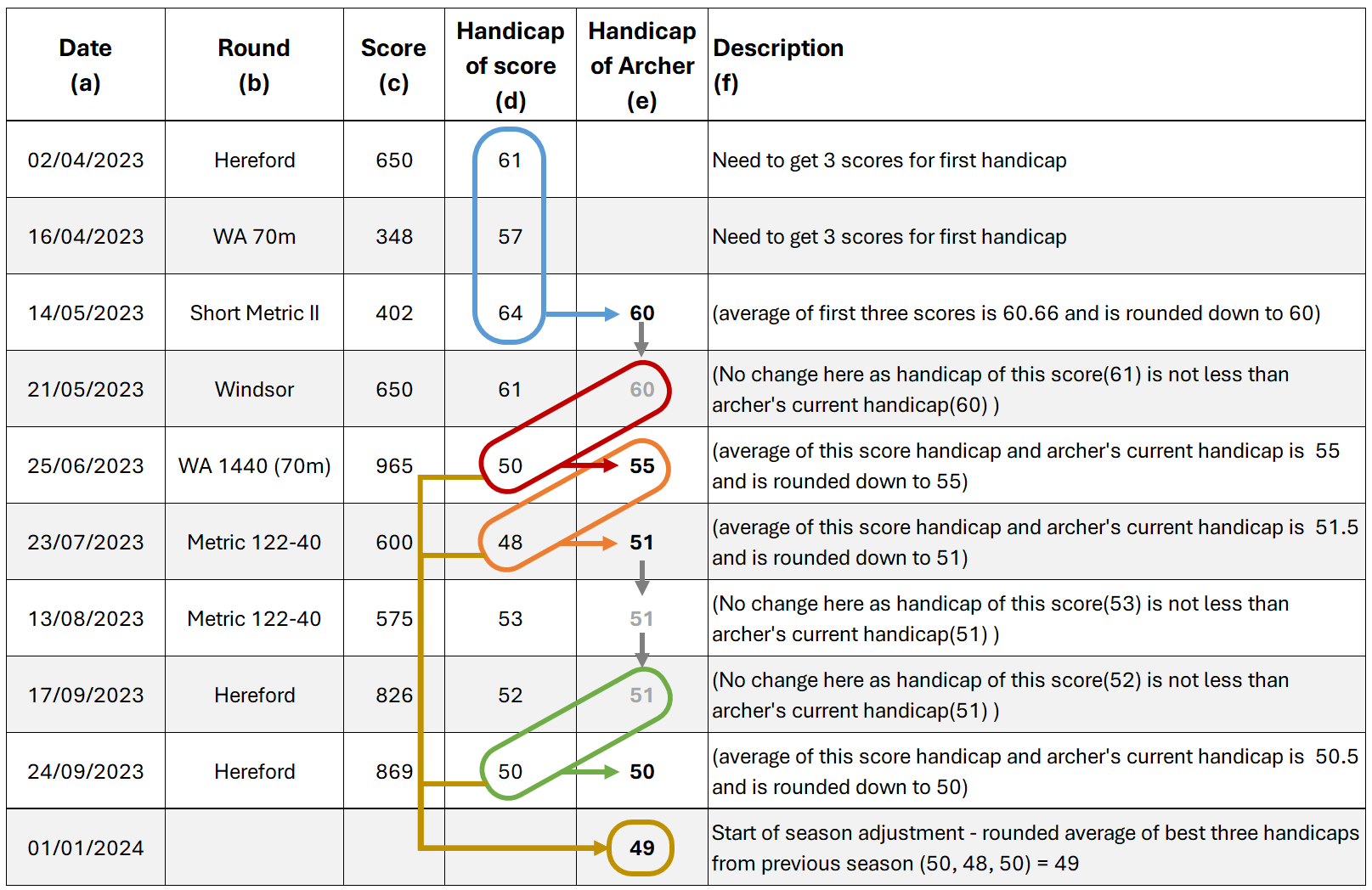Handicaps are an important concept used in UK archery, and some other countries too. They are not as well-used as they were in the past, but it’s a really useful idea to know about that can help you in numerous ways.
What is a handicap?
Just like in other sports, most notably in golf, a handicap system is used in archery. Put simply, an archer’s handicap is a rating of how good they are, or more precisely a rating of their ability to shoot a tight group of arrows. 0 is the best handicap with the tightest groups, and 150 is the lower end of the handicap scale where arrows would be quite widely scattered.
The mathematics of the handicap system model the scatter or spread of an archer’s arrows, and calculate what scores you would expect if you then put a certain size target face in front of those scattered arrows at a given distance. That means we can work out what score we would expect for a given handicap, and vice versa, calculate the handicap for a given score.
Do I need to understand how it works?
No, definitely not.
You don’t need to understand exactly how the system works in order to use it, because all of the work is done already and published in the form of Handicap Tables. The official handicap tables show the scores you would expect on any official round, for every handicap from 0 – 150. The official handicap tables are available from ArcheryGB here, or you can create tables using ArcheryGeekery’s own table generator here.
Using the tables is easy. Take a look at the following example

So, for example, let’s say someone just scored 1230 on a York round. To work out the handicap, we go to the tables and look down the York column. 1230 is not shown, but clearly sits somewhere between 12 and 13, and we always go to the next higher handicap (lower score) if there is no exact match (SAP9 3b). So, 1230 on a York is a handicap of 13.
A handicap of 13 really just represents a particular amount of arrow scatter. Shooting with that same level of scatter on other rounds would likely get scores similar to the other scores shown in that same 13 row. This is a useful property of the handicap system that allows you to see what score you could expect to achieve on one round, given your score on another round.
How do I get a handicap?
So far, we’ve seen how an individual score has a handicap, so how does an archer get a handicap?
In most clubs there is a Records Officer. The records officer has the job of figuring out what everyone’s handicap is. As shown above, it’s quite easy to find out the handicap for a given score, but the Records Officer will calculate the handicap rating of an archer. They would normally use software for this, but the process is relatively easy to do manually too.
Setting the initial handicap
- An archer only gets their first handicap after they’ve shot 3 scores on official rounds.
- That initial handicap is calculated by averaging the handicap of the 3 scores. If that average is not a whole number, we round down to the next whole number.
Updating the handicap when new rounds are shot
- During a season, every time an archer shoots a new score, the Records Officer will –
- Calculate the handicap of the new score
- If it’s lower than the archer’s current handicap, take the average of the new score’s handicap and the archer’s current handicap to be the the new handicap (rounding down if not a whole number).
- If it’s equal or higher than the archer’s current handicap, the handicap stays the same.
Annual Reassessment
At the start of each season (1st Jan for outdoors, 1st July for indoors), the handicaps are reassessed. During the season, the handicap changes as a moving average, but for this reassessment all the scores from the season are used. The reassessment process is –
- Look at all the score handicaps of the last season
- Take the best 3 and average them to be the starting handicap for the new season. (again, rounding down if necessary)
- If the archer hasn’t shot 3 rounds, average what has been shot with the start-of-season figure for the previous year.
Worked example
Let’s take a look at the season of a fictional archer, a beginner with no existing handicap. The table below shows all of her scores for a variety of rounds shot through the season, and contains the following columns
- (a) – Date the round was shot. For the purposes of handicaps and classifications, the outdoor season runs from the 1st January to the 31st December each year (even though many clubs disappear indoors for half of that), and the indoor season runs from the 1st July to the 30th June.
- (b) – The round that was shot. For handicaps, any round listed in the Rules of Shooting (Tables 3-1, 3-2, 3-2a, 3-3, 4-1) can be used. There are no restrictions on age, gender or bowstyle (apart from indoor rounds where compounds score differently).
- (c) – Score the archer shot on the round
- (d) – The handicap of the score. This is found by looking up the score in the handicap tables. If the exact score is not listed in the tables (most of the time it won’t be) then the next highest handicap is taken.
- (e) – The current handicap of the archer on the given date

We can see here how this archer starts with no handicap, and only after their first three rounds do we calculate the initial handicap by averaging the handicap of the first 3 scores.
After that the archer sometimes shoots scores which are worse than their current handicap, and so there is no change (the grey arrows). Sometimes, the new handicap is better (lower), than their existing handicap, so the two are averaged and then rounded to create the new handicap (shown in the coloured boxes).
At the start of the next season, regardless of what their handicap ended up at after the season’s shooting, the archers three best handicaps of the year are averaged to create the starting handicap for the 2024 season.
Multiple Handicaps
Archers tend to have multiple handicaps, for a couple of reasons.
First, shooting outdoors is quite a different discipline to shooting indoors and so each archer will have a completely separate indoor and outdoor handicap. The rules and procedures are the same, but the two are maintained completely independently.
Second, you need a separate handicap for each bowstyle. Theoretically, if you routinely shot recurve, compound, barebow and longbow, both indoors and outdoors, you might have 8 separate handicaps, and you should thank your club Records Officer profusely for calculating them all for you.
What are handicaps used for?
Now that we have a handicap, a rating of how good an archer is, what can we use it for?
Levelling the playing field between archers
When archers of diffreent skill levels or bow types are shooting together, it normally wouldn’t be possible for them to compete meaningfully against each other. However, we can use each archer’s handicap to adjust their scores to mathematically level the playing field.
This is done using the handicap allowance tables which look just like the handicap tables, but instead give a number of “bonus” points that an archer of a particular handicap is given on a particular round. You can see the allowance tables here. The allowance tables are created such that if you shoot as well as your handicap would suggest you would, then your score plus your allowance would be 1,440 points. If it comes out higher than that then you’re shooting better than your handicap would predict, and if it’s lower, then you’re not having as good a day as you normally do.
Some competitions are run as handicap tournaments, and these allowance tables are used to adjust everyone’s scores at the end of the event. Sometimes a handicap award is given on top of all the awards in specific categories. All archers can compete against each other in a handicap event, regardless of age, bow type or ability.
Comparing between rounds
The skill rating given by the handicap is a useful leveller across rounds too. If you only ever shoot the same round over and over again, it’s easy to track your progress, but if you shoot lots of different rounds, how do you really know if you shot as well as you normally did or not?
The handicap tables answer this question for you. By comparing the handicaps of your scores rather than the scores themselves, you can see which score is actually better, because it will have a lower handicap. You can do that manually using the handicap tables themselves, or by using specific tools, like the ones elsewhere on this website.
Tracking Progress
Your handicap is quite a sensitive measure of your skill level, and so you can use it to track your progress over time. You can even plot it on a graph (most scoring or records management software will do this for you) to get an idea of your improvement over time.

Of course a handicap scale that runs from 0-150 is quite a lot of small steps, and whilst that’s useful to track small improvements, it’s also useful to mark and celebrate significant milestones along the way. For example for Recurve Women those key milestones are at handicaps 77, 70 63, 56, 49, 42, 35, 28 and 21 – this is the classification system, with a handicap of 77 known as “Archer 3rd Class” and a handicap of 21 known as “Elite Master Bowman”.
The third article in this beginners series will look at that classification system in detail, but essentially it really is just 9 specific handicaps chosen for each category of archer where special recognition is given.
Handicap Resources
The official ArcheryGB Handicap Tables
- ArcheryGeekery’s custom handicap table generator
- ArcheryGeekery’s handicap calculator (calculates handicap for a given score, quicker than looking it up on the tables)
- ArcheryGeekery’s comprehensive handicap tools (for calculating handicaps for custom rounds, and other tools)
Next part in the series: Outdoor Classifications
Leave a Reply